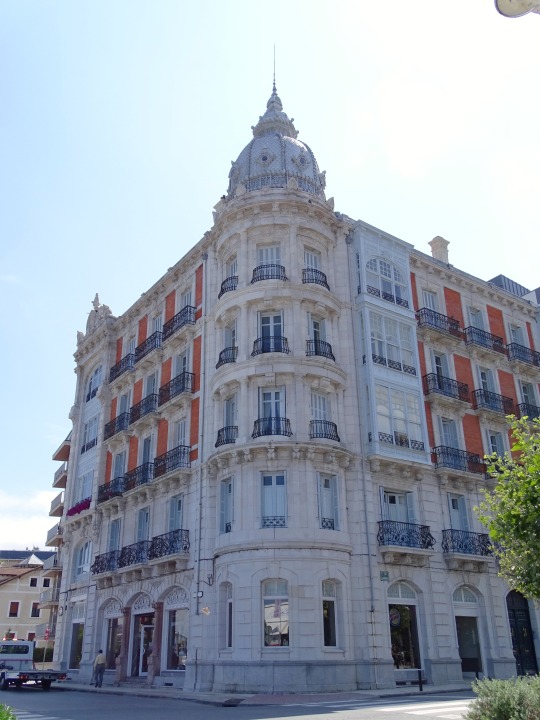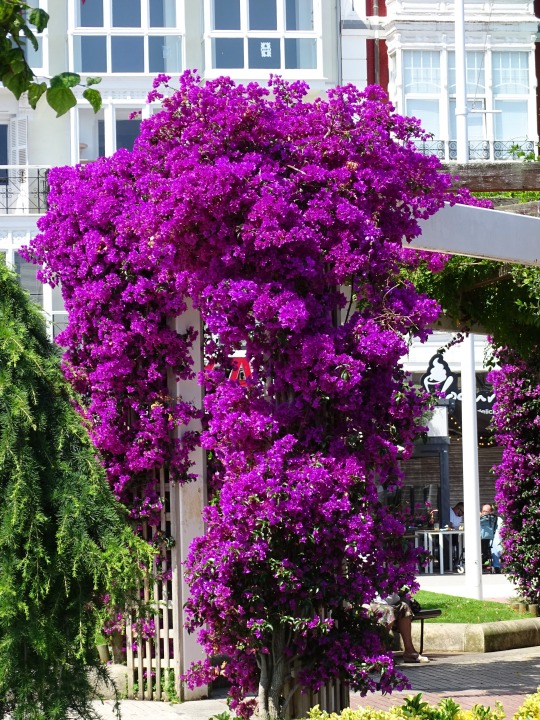#Casa para Isidra del Cerro by Severino de Achúcarro
Photo










Castro Urdiales, Spain (No. 4)
House for Isidra del Cerro
This beautiful residential building with commercial basements was designed by the architect Severino de Achúcarro in 1899, who entrusted the construction management to his disciple, the Castro-born architect Leonardo Rucabado, with whom he also carried out the Casa de los Chelines.
This property clearly shows the French and modernist influences of Achúcarro. It has a façade facing three streets, a mezzanine, three floors and a mansard-roofed attic, although the façade facing the sea is particularly striking for its set of balconies and viewpoints and its stonework rotunda.
The decoration is very striking and the use of wrought iron in railings and viewpoints stands out. On the left side the wooden viewpoints stand out, and on the right the chamfer crowned by a slate dome, which is decorated with scales and portholes.
This stone corner has three openings on each floor that become balconies from the second floor. Apparently, the House for Isidra del Cerro was the first building in northern Spain in which an elevator was installed, although it was never used.
Source
Royal Building
The architect Eladio Laredo, commissioned by the industrialist Luis de Ocharan, designed this residential building between 1901 and 1903 used as a hotel. With a certain Neo-Gothic eclecticism, it consists of a ground floor and three heights.
The sober façade includes elements that evoke the coats of arms of the Catholic Monarchs and Emperor Charles. As an originality, the angle of the building is finished off with a tower with a medieval air that shelters an internal helicoidal staircase.
Source
#Casa para Isidra del Cerro by Severino de Achúcarro#coat of arms#Cantabria#Castro Urdiales#Monumento a Ataulfo Argenta#Parque de la Música#travel#Edificio Royal by Eladio Laredo#Neo-Gothic eclecticism#façade#exterior#architecture#original photography#flora#palm tree#lawn#landmark#tourist attraction#summer 2021#Northern Spain#Southern Europe#vacation#España#Spain
4 notes
·
View notes
Photo










Castro Urdiales, Spain (No. 1)
Severino de Achúcarro y Mocoroa (Bilbao, 1841 - Paris, 1910) was a Spanish architect representative of his time, dominated by eclecticism, with an evolution towards modernism, and especially, art nouveau.
He studied at the School of Architecture in Madrid, graduating in 1866, later expanding his training in Angoulême and Paris. Throughout his life he was closely related to the Gallic country, where he also came to design some buildings.
He was a capital figure of nineteenth-century Basque architecture, because in his youth he triumphed in several competitions and received commissions from the Bilbao City Council.
He designed and intervened in many buildings of the Villa del Nervión such as the headquarters of the Society El Sitio in Bidebarrieta Street (current Municipal Library of Bidebarrieta), the reform of the façade of the Cathedral of Santiago, the Hotel Términus, the Santander Train Station -old station of La Concordia- (1898), the building of the Bank of Bilbao (of the Plaza de San Nicolás, 4) with Eugéne Lavalle and Enrique de Epalza (1898), numerous tenement houses such as Sota in Alameda Mazarredo, or Casa Isidra del Cerro (1899) and Los Chelines (1902) in Castro Urdiales, among others. In addition, in 1876 he elaborated, together with Pablo de Alzola and Ernesto Hoffmeyer, the Plan de Ensanche de Bilbao.
His is also the casino of Bermeo (Vizcaya) of 1894.
He died in Paris, on one of his countless trips to France, in 1910.
Source: WIkipedia
#Casa para Isidra del Cerro by Severino de Achúcarro#Amestoy Park#Spain#Edificio Salvarrey#art nouveau#architecture#cityscape#travel#Jugendstil#façade#flora#nature#flower#tourist attraction#landmark#Cantabria#Castro Urdiales#Severino de Achúcarro y Mocoroa#Northern Spain#vacation#summer 2021#Southern Europe#original photography#España
4 notes
·
View notes